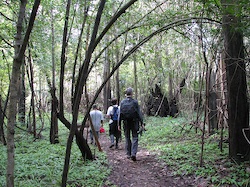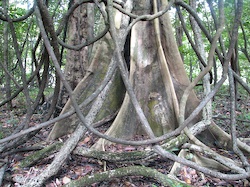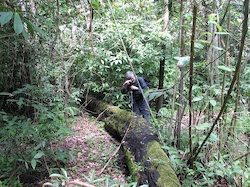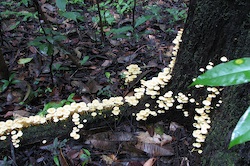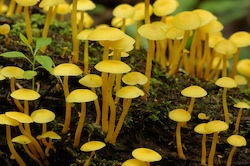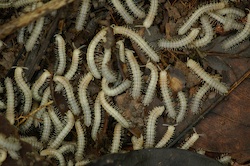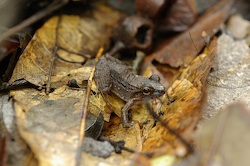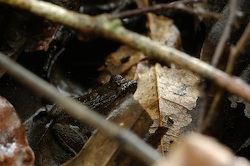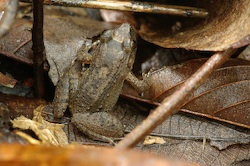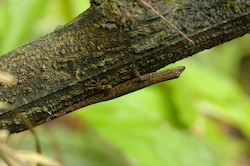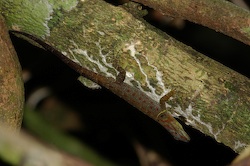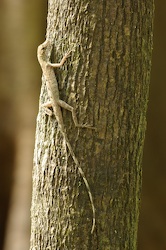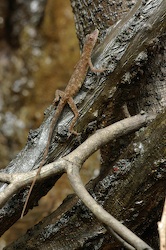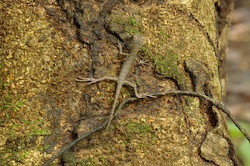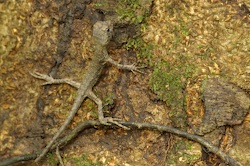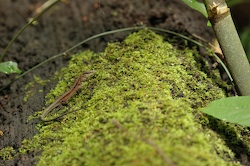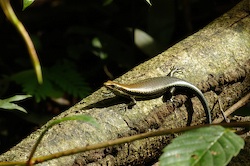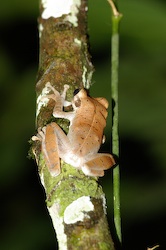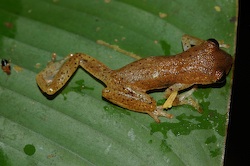|
MAMIRAUÁ ON FOOT (A.K.A. HERPING IN THE NON-FLOODED FOREST) We visited Mamirauá near the beginning of the wet season, when the water level was still low, which meant that it was still possible to hike on trails in the forest. This meant of course that I spent my time looking carefully for lizards, snakes, and frogs while everyone else was looking for monkeys and jaguars. You get bonus points if you can tell which of the lizards pictured below is the target of my camera in the third picture above. We did see some monkeys while hiking, though they were high up in the trees and weren't photograph-worthy. We did not see any jaguars. As in other tropical rainforests, the nutrients of plant matter fallen to the forest floor are quickly released by various decomposers. The most obvious ones we saw were a variety of fungi, and a fantastic number of small millipedes. The forest floor was always damp, and during much of our hiking time rain was falling. This wasn't so great for the lizards and snakes, but it was a boon for the frogs. Every once in awhile one of our guides would notice a small hopping motion near their feet. Then we'd stop to poke around in the leaf litter, and about a third of the time we could eventually locate the well-camouflaged culprit. I believe all of these little guys are Forest Chirping Frogs (Adenomera andreae). I also saw one beautiful little Pale-striped Amazon Poison Frog (Epipedobates hahneli), but it tragically leapt off a log and into concealment just as my brain registered that the bright little jewel I had noticed was a frog, so I didn't get a photo. I didn't see many lizards of any kind, but the lizards I saw the most of were these small Bridled Forest Geckos (Gonatodes humeralis). I saw about ten of them at Mamirauá, and another ten or so in Manaus. The females were medium to dark brown and fairly drab, like the one in the first picture above. The males had a yellow collar and pretty red spots, like the one in the second picture above. They were extremely wary of the approaching camera; I was lucky to get any halfway decent photographs. The next most common lizards were these graceful, delicate anoles, of which I saw just five or six in several hours of hiking. I believe these are Slender Anoles (Anolis fuscoauratus). This is the strangest lizard we came across. Monica spotted it clambering around a tree trunk. It didn't move as gracefully as the Slender Anoles, and with splayed legs and a sideways crawl it looked almost like a long-legged crab or spider. At first I thought it was some other, clumsier type of anole, but after getting some comments from photos I posted at fieldherpforum.com, I eventually came to the conclusion that it was a tiny baby Uranoscodon superciliosus, which has earned a variety of English common names including Brown Tree Climber, Diving Lizard, and (my personal favorite) Mop-headed Iguana. This was the only teiid lizard I saw out in the forest. I believe it's the same species as the ones I mentioned earlier that lived on Uakari Lodge, which as you no doubt recall I believe to be Forest Whiptails (Kentropyx pelviceps). The last of the lizards we saw in the forest were a couple of these skinks. The Mamirauá guidebook didn't include any skinks on its reptile list, so I got no help identifying it from there. After looking in some other books and searching the web, I think that this skink is the Black-spotted Skink (Mabuya nigropunctata). However, I also found some discussion of a closely related and similar-looking skink that could live in this area, the Two-lined Skink (Mabuya bistriata). I could definitely use some more help choosing from these two alternatives. We only went hiking in the forest at night once, and only for a short time. We saw two frogs during that time, and I'm not sure of the identify of either. This first one was a large treefrog; it went shimmying up this thin trunk in no time. It might be one of the two Osteocephalus species I saw on the grounds of the lodge (O. leprieurii and O. taurinus), but I'm not sure. Any ideas? This second frog seen in the forest at night was quite small, about an inch long (snout-vent length). I have so far been unable to find any likely candidate in my reference books or on the web. Can you help? |
